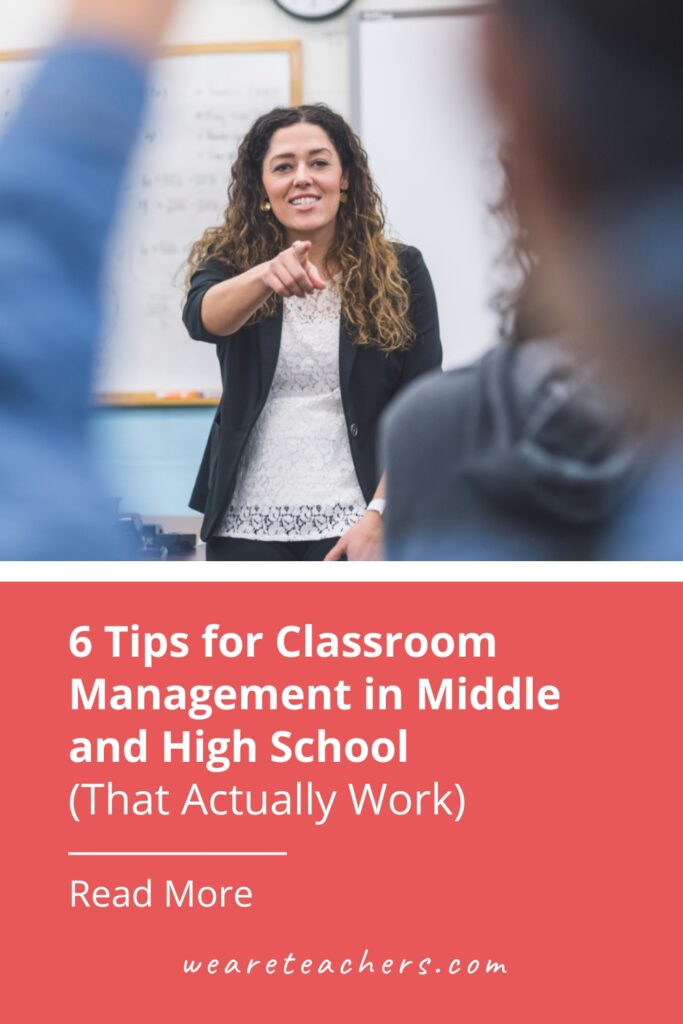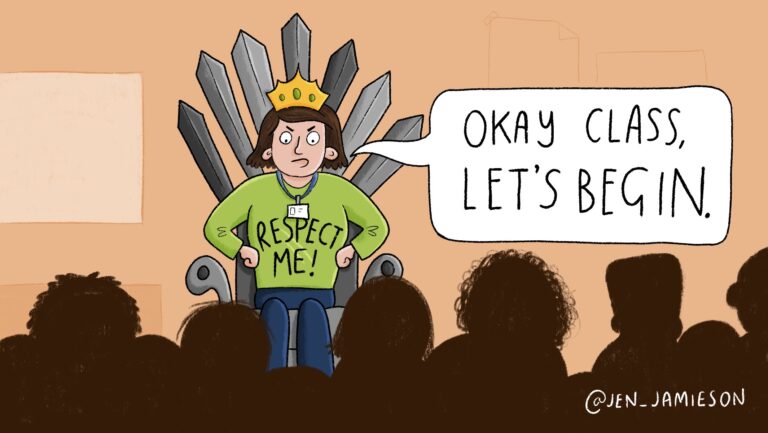Classroom management was my biggest struggle as a new teacher. I went in suspecting I would have classroom management in the bag because I’d had pretty extensive experience working with kids from babysitting, being a camp counselor, and taking on similar volunteer-type roles. But as it turns out, managing a classroom was way different and way more difficult than anything I’d done before.
In my first year, I had no procedures in place and thought that my kindness would be enough for students to listen to me.
That went about as well as you’re imagining.
In my second year, I overcompensated for my leniency the previous year. I had near-perfect control over my classroom, but I was so strict at the beginning of the year that it made it difficult for my students to relate to and/or trust me. Also not good.
My third year is when things started to even out. I knew I needed to have set boundaries and be firm with my students who pushed them, but I also wanted a classroom environment that was warm and engaging. I would say by my fifth year, I felt efficient—even good at striking the balance I wanted. By year 10 and beyond, it was like second nature.
Classroom management isn’t like following a recipe, where you follow exact steps and end up with a beautiful finished product. It takes time, practice, and patience. But here are the six biggest tricks I’ve learned to help move that process along.
1. Find someone on campus to emulate.
Do you learn best by example? Same.
One of the most powerful and transformative PD experiences I ever had was watching a master teacher on campus. You can pick up wisdom here and there in PLCs or on curated moments on TikTok, but observing a talented teacher bell-to-bell is like taking a master class. It showed me, first, that the type of teaching I dreamed of was possible. But it also gave me practical classroom management strategies to take back to my classroom and questions that opened up new areas and possibilities for me to explore.
I recommend setting up regular opportunities to observe so you’re not just watching in October when the classroom is well established, but at multiple points in the year. Pro tip: Put these observations in your beginning-of-the-year goals to ensure your leadership prioritizes them.
2. Assume best intent (but acknowledge the impact) when they mess up.
In my experience, I’ve noticed that students tend to get the most hostile and disinterested when they think their teacher doesn’t like, trust, listen to, or believe in them. This makes sense, right? Adults are the same way.
It’s easy to show that you think your students are great when things are going great. But it’s especially important to lean into their greatness when they mess up. Don’t assume or narrate their intentions—it’s not worth it and it’s always a losing battle.
Imagine that you came home from the store without an item your spouse or roommate asked you for. Both of these responses acknowledge the impact of the mistake, but only one assumes best intent:
“I’m sick of your selfishness. Don’t tell me you did it on accident. You can only say it’s an accident the first time; after that it’s intentional. Just be honest: My needs don’t matter as much as your own. I don’t want your apology. Just do better.”
“Thanks for apologizing. I’m disappointed, but I know you didn’t do it on purpose and I forgive you. Let’s think about how we can keep this from happening in the future. Should we look into an app where we can share the same list and update it in real time?”
Which response would make you feel safe and understood? Which response protects the relationship? Which response creates less of an impulse to carve curse words in your desk?
Read more on this approach here (as well as some real classroom examples I’ve had to use.)
3. Build classroom culture with a fun or quirky tradition.
I think it’s unrealistic to expect teachers to make every moment of learning fun. Come on, y’all. We’re competing with algorithms here.
Instead, build something into your daily, weekly, or monthly routine that’s not only fun for students, but that you’ll have fun with, too. It doesn’t need to be flashy, extravagant, or expensive. Here are some simple examples from real teachers on how they build classroom camaraderie:
- “I love doing Monday morning share! I get to hear about their weekend, and they get to hear about mine. We celebrate good weekends together and sympathize with bad weekends. It also makes Mondays something to look forward to!”
- “My classes are split into four houses named after four great thinkers/innovators: Nikola Tesla, Maryam Mirzakhani, Percy Julian, and Ida B. Wells. Students get ‘sorted’ with the Sorting Hat, and their first project is to research their founder and teach a lesson to the rest of the group about him/her. They get house points for answering warm-up questions, being awesome, etc., and I randomly give prizes to whatever house is in the lead.”
- “I’m in a portable, so I have a sidewalk out front. I use sidewalk chalk to write students notes on their birthdays, write quotes, or wish them good luck on testing days. It makes for something special that everyone in the school can see when they walk by.”
- “On the first day of school, I ask each of my eighth graders to address a blank postcard for me. The most time-consuming part of mailing home a note is addressing envelopes/cards! As the days/weeks pass, I’ll write a thoughtful note to my students and mail them. I was surprised by how much teenagers love getting mail at home, and it’s such a fun way to build a positive relationship with your students and their families!”
- “I teach high school Spanish. I wait outside to greet my students, and every day I have a new question for each of them. Usually it is somewhat related to the vocabulary we are studying, always in Spanish, and I try to make it as personable as possible ‘Do you prefer cats or dogs?’ ‘Favorite dessert?’ At the beginning of the year, they are all kind of weirded out by it, but by Thanksgiving they all wait for their question. If I don’t ask them, they tell me they want their question!”
- “I put stickers on the outside of their reading journals rather than the pages inside. I teach in Ohio, so they always compare it to the Ohio State football players’ helmets.”
- “On my door: ‘Late? No entry without dancing.'”
- “We use the sign language symbol for ‘I love you’ to respond when a student shares a writing, when they admit to something difficult—pretty much whenever we feel one of us needs and/or deserves love or appreciation. I don’t like clapping as it sometimes becomes a symbol of popularity (louder = more popular). The kids are pretty awesome with this one. Someone will be sharing a writing about sadness, and the signs just go up. It makes me cry.”
Plus, check out this secondary teacher’s beloved class tradition that is a task you have to do every day anyway.
4. Learn to not take outbursts and defiance personally.
This is a skill that comes with time. But the sooner you understand that this is the goal, the sooner you can get there.
Do not let teenagers be in control of your feelings. They are barely in control of theirs.
This is not to say you should ignore or dismiss disruptive, rude, or defiant behavior. Just handle it with the knowledge that your students probably didn’t wake up this morning and say, “I cannot wait to make Mrs. Evans question her personal worth.” There is a lot happening in their bodies and minds that, because of their brain development, may feel unmanageable. Hormones. Climate anxiety. Insecurity. Friendship troubles. Changing relationships with their families. School stresses.
Think about the last time you behaved out of character. Was it really because your Wi-Fi was out? Or were you tired, hungry, overstimulated, covered in toddler goo, and just wanted 30 minutes to zone out and watch Love Is Blind?
Usually, we behave our worst when there’s a convergence of factors (and often in front of people that feel the safest to receive our lowest behavior). Understanding this about ourselves makes it a lot easier to understand and forgive in our students.
5. Tighten up your transitions.
You’ve seen this play out if you’ve ever been to a group PD with a disorganized speaker. Teachers (like teenagers) are already a tough crowd, but they’re especially tough when there’s a lull.
“Hang on just a second, I’m not sure why this isn’t working. …”
“Let’s move on to the next activity. Go ahead and get out something to write with and a piece of paper.”
“OK, everyone, get in groups of five. …”
Clunky transitions mean people start getting antsy. Fidgety. Chatty. Teenagers are the same way.
Getting your transitions short and precise requires some planning. Be strategic about the materials you’ll need and quick ways of distributing them. Plan in advance for a quick way of dividing groups. Prep any technology ahead of time, including links, videos, and other demonstration tools.
Use timers (I recommend having an online one and a large clock timer handy) to establish a boundary for students to complete the task—and to help you manage difficulties that will inevitably pop up. (“I have two minutes on the timer for you to tell your neighbor about your favorite childhood TV shows while I restart my computer.”)
6. Challenge how consistent you are with expectations.
A lot of times, teachers will get frustrated by students ignoring expectations without realizing they might be lacking consistency in enforcing them. I’ll give an example using something I did A LOT.
Me: OK. I need total silence while I explain this assignment. Save questions, comments, anything that’s not an emergency until I’m done with my explanation. It’ll take five minutes max.
Student: It’s raining.
Me: (turns to window) Oh, yay! So glad we’re getting some rain. OK. Back to the assignment … (2 minutes later)
Student: Oh! Could we do this as a movie trailer instead?
Me: I love that idea!
(Students start chatting excitedly.)
Me: I said I needed total silence for this explanation!
See what happened? I told students my expectation was silence, but then I repeatedly allowed students to interject, contradicting the expectation I’d set and confusing my students.
This happens a lot for expectations around noise levels, but it can happen with any procedure. If you expect students to push in their chairs, check for it when they line up—and send students who didn’t back. If you expect students to disagree respectfully during a writing workshop, intervene when they don’t, and remind everyone of your expectations. Teachers tend to say “I shouldn’t have to tell you to do [long-practiced procedure],” but the truth is … you kind of do.
Classroom management is definitely one of the trickier aspects of teaching. But with enough hard work, honest reflection, and feedback from people you trust, you’ll soon start to see little glimmers that you’re improving.
For more articles like this, be sure to subscribe to our newsletters.


